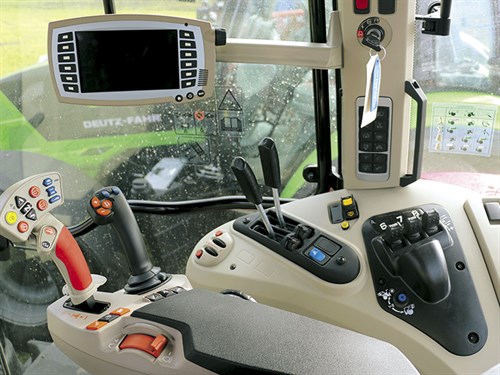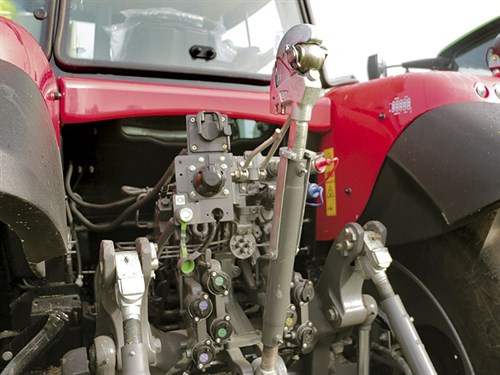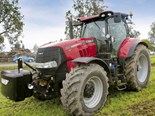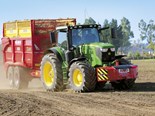TTSO 2017: Massey Ferguson 7720 DYNA-VT

















|

|

|

|

|

|

|

|
The Massey Ferguson 7720 Dyna-VT had its fair share of supporters at the Top Tractor Shoot Out competition, and justifiably so
While the Massey Ferguson 7700 series is a relatively new model (released last year in New Zealand), it is largely just a continuation of the popular 7600 series with a few tweaks. The range stretches from 140hp to 255hp with two different spec levels – essential and efficient – and three different transmission options – Dyna-4, Dyna-6, and Dyna-VT. I'd say that covers all the bases. To meet the CVT transmission requirement for our Top Tractor Shoot Out, AGCO put forward a 7720 Dyna-VT in the efficient spec.
Engine
Under the bonnet is what used to be a SISU engine. This was recently renamed an AGCO Power engine. It is a six-cylinder 6.6-litre turbocharged common rail engine, rated at 200hp with an intelligent EPM (engine power management) that delivers an additional 25hp when demanded.
As we have noticed in the past and again this year, these engines always perform well on the dyno and the readings are close to their stated horsepower. This year, the 7720 delivered an impressive 199hp to the PTO shaft or 211hp once we discovered how to turn the boost on when the tractor wasn't moving.
The torque curve is equally impressive. Relatively flat, it shows plenty lugging power across the engine rpm range. European Tier 4 final emissions standards have been met by simply using SCR (Selective Catalytic Reduction), which in layman's terms, is AdBlue sprayed into the exhaust.
This is a great simple solution that doesn't require replacement down the track or downtime with burn cycles. The one downside that could be argued will be higher AdBlue usage levels than other machines with multiple levels of emission controls. The diesel tank has an impressive 430-litre capacity along with a 40-litre AdBlue tank.
Transmission
A reliable Dyna VT transmission is used in the Massey Ferguson 7720. This is essentially exactly the same as found in the other premium brand tractors sold by AGCO, except it is priced cheaper, which sounds like a win to me. In operation, it is extremely smooth and effective at delivering the power to the ground under load. The field and road mode ranges limit forward speed to optimise torque and control, depending what the tractor is being used for.
While there is a lot of functionality built into this transmission, where most aspects such as the aggressiveness or the relationship between forward/reverse speeds can be adjusted, I think that it is not very intuitive how these adjustments are made and will require serious studying of the manual to get the full benefits. On the positive side though, it is straightforward to get in the tractor and get moving.
The movement is easily controlled by the foot pedal or joystick on the right-hand armrest. The joystick is simply pushed forward or backwards to control the speed, and it is great to see buttons on top of both joysticks to change direction as well as a left-hand shuttle lever.
Serviceability
For a 200hp tractor, the engine is still slung nice and low to the ground. This not only increases stability but also makes servicing and daily checks remarkably easy to perform from ground level. The oil can be checked without opening the bonnet, and another great idea is a third extra fuel filter to ensure that any contaminates in the fuel are removed before getting to the engine.
The Massey Ferguson 7720 was also one of the few tractors in the lineup to use separate transmission and hydraulic oils. This rules out any cross contamination to the transmission when hitching up implements with oil in them, which is a great feature.
Service intervals sit at 250 hours for the engine, 1000 for the hydraulic oil, and a massive 2000 for the transmission oil. A two-year or 2000-hour warranty provides peace of mind for new owners.
I found it interesting that the cooling packs are fixed in place and don't open out like many other tractors. Supposedly, this is because Massey Ferguson believes hinge points create weak spots and unnecessary wear, which I guess does make sense.
The radiators are still arranged so they are easy enough to clean. Diesel and AdBlue tank fillers are where you would expect to find them – logically beside the left-hand
steps to the cab and are colour-coded to help prevent confusion.

Operator environment
Massey Ferguson has stuck with its distinctive six-pillar design cab and although there are extra pillars that get in the way for visibility, many feel that the curved rear side windows make up for anything that is lost. It's the same story of the doors. Anything lost in terms of accessibility compared to large single-piece doors on other tractors is made up for in how easy they are to open and close.
Once in the cab and on the air seat, the environment feels light and open. Visibility out the front is good, thanks to a sloping bonnet and a tapered chassis. Although the passenger's seat feels more like a perch than a seat, we all know they are there for training purposes only.
Mechanical cab suspension offers up a smoother ride as does the redesigned front axle suspension with more than 100mm of travel to soak up the bumps. This uses two hefty hydraulics set out at an angle from the chassis to the axle, giving good stability under load. The dash tilts forward with the steering wheel and is clear and well laid out. It now uses a colour display, with information such as tractor performance, work rates, fuel consumption, and operating temperatures.
Controls
The controls are quite spread out around the cab, which the judges agreed somewhat detracts from the functionality. First up on the armrest, the main joystick controls movement of the tractor. Among other things, it has buttons for the rear linkage, one programmable remote valve, and two cruise control set speeds. Also on the armrest is a hand throttle and pre-set engine rpm buttons, along with a second joystick that offers great control for the front linkage or if a loader is fitted.
It is good to see buttons to control the direction of travel. Controls for the remaining remotes are found on the right-hand console and are a mix of levers for the mechanical remotes and fingertip toggles for the electric ones. The rear PTO has four speeds, which is more than many other tractors in the lineup. Speeds are selected with buttons found at the top of the cabs 'B' pillar while the PTO on on/off is found on the right-hand console. Almost all other controls are laid out down the 'B', which puts them in easy reach but slightly out of your eye line when driving. The ignition key is also found on this pillar.
The Datatronic 4 display monitor uses a seven-inch colour screen to display in-depth info, form work rates to how the tractor is set up and allows greater control of various functions. It can also be used to set up headland management sequences, allow for a single camera input, and is fully ISOBUS compatible, allowing implement management screens to be displayed. While this monitor is adequate, in comparison to most other tractors present, it was quite small, lacked functionality, and can be a little difficult to navigate through the displayed info.
Hydraulics
A closed circuit load sensing hydraulic system uses a variable displacement swash plate pump, which is rated to put out 110 litres oil per minute. Impressively, our independent tests by DPS managed get a maximum of 102 litres per minute out of a single spool, which will be more than adequate for most tasks.
Carrying seven sets of hydraulic remote valves made up of four at the rear and three at the front, including one to operate the front linkage, is more remote than any other tractor in the Top Tractor Shoot Out and provides plenty of options. Of the four rear remotes, two are electronic and two mechanical.
The Massey was also the only tractor to still have mechanical remotes. Release levers on the rear couplers are great to see and make uncoupling hoses easy. In the cab, controls for the hydraulics are a little mixed and confusing. There is a cross gate joystick on the armrest for two remotes, push buttons on the top of the main joystick to control a further set, and three fingertip buttons on the right-hand console.
Control can be can be swapped and there is limited ability to assign remotes to different controls through the monitor. The two mechanical spools use levers found on the right-hand console. Flow rates can be adjusted on the Datatronic screen. Load sensing power beyond valves and a hydraulic trailer brake at the rear were good to see.

Linkage
Simple and effective linkage controls are important and they are fairly straightforward in the Massey. There are up and down buttons on top of the main joystick as well as a scroll wheel down the side of the armrest for fine control of the height.
As you would expect, there are controls for max height, raise/drop rate, draft, etc, which can all be easily adjusted. I don't like the fact that the linkage must be first unlocked before it will move even when using the external controls, but I know everyone will say that it's for safety. The rear lift capacity is stated at 9900kg at the Cat 3 hook ends, which made hitching the tractor to the Sumo Trio straightforward. Stabilisers were also easily adjusted. External buttons to control the rear linkage are on both rear mudguards, as well as a PTO stop button – great to see and helpful when hitching implements.
The front linkage has a respectable lift capacity of 4000kg, which will prove more
than ample for most tasks. Interestingly this was one of the few tractors in the lineup that had a front linkage but no front PTO, which does limit usefulness, but a front PTO is definitely an option.
Performance
Put through its paces out in the field on a 3.5m Sumo Trio, the Massey performed exceptionally well. The 6.6-litre engine poked out plenty of power across a wide rpm range. The transmission is good at getting this power to the ground with minimal losses and keeping the tractor moving forward at a reasonable speed even under tough conditions.
Hitched up to the Herron trailer (with a gross weight of more than 21 tonnes), the tractor once again proved itself and was more than comfortable getting smoothly up
to speed. It felt well balanced when travelling with this weight behind it and there were no problems stopping with the help of the hydraulic trailer brakes.
As mentioned earlier, our dyno results were impressively close to the stated max engine rpm, setting the Massey apart as one of the few tractors where you actually get the horsepower that you have paid for, and resulting in an impressive figure of 900 dollars per horsepower. Fuel usage on the dyno sat at 38.9 litres per hour, which when worked out on a horsepower basis was an impressive 0.195 litres per horsepower per hour.
Verdict
Overall, there are some pleasing results for the Massey Ferguson 7720. The AGCO power engine did exceptionally well on the dyno and was the closest to its stated horsepower giving real value for money when it comes to power. These results were in line with our findings in the field where everyone agreed it got the power to the ground and pulled exceptionally well.
The build quality is exceptional throughout and the suspension setup offered a smooth, well-balanced ride. The hydraulic system also performed well and the tractor had the highest number of remotes of all tested.
While we agreed other tractors were more functional in terms of cab layout, the decision lies with how much functionality is required and sometimes good economic reliable horsepower is hard to beat.
Top features
- Seven sets of hydraulic remote valves
- Separate hydraulic and transmission oils to reduce contamination
- Large fuel tank capacity
- Great value dollars per horsepower
- Four-speed rear PTO
- Good overall serviceability
For complete specifications, check out the latest issue (#243) of Farm Trader
Keep up to date in the industry by signing up to Farm Trader's free newsletter or liking us on Facebook
















